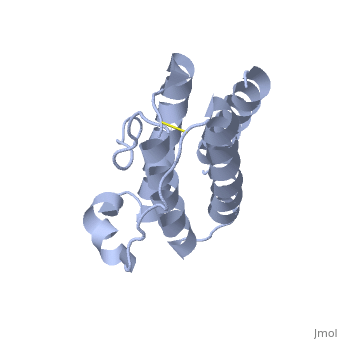1ax8: Difference between revisions
Jump to navigation
Jump to search
No edit summary |
No edit summary |
||
| (One intermediate revision by the same user not shown) | |||
| Line 1: | Line 1: | ||
==Human obesity protein, leptin== | ==Human obesity protein, leptin== | ||
<StructureSection load='1ax8' size='340' side='right' caption='[[1ax8]], [[Resolution|resolution]] 2.40Å' scene=''> | <StructureSection load='1ax8' size='340' side='right'caption='[[1ax8]], [[Resolution|resolution]] 2.40Å' scene=''> | ||
== Structural highlights == | == Structural highlights == | ||
<table><tr><td colspan='2'>[[1ax8]] is a 1 chain structure with sequence from [ | <table><tr><td colspan='2'>[[1ax8]] is a 1 chain structure with sequence from [https://en.wikipedia.org/wiki/Homo_sapiens Homo sapiens]. The May 2012 RCSB PDB [https://pdb.rcsb.org/pdb/static.do?p=education_discussion/molecule_of_the_month/index.html Molecule of the Month] feature on ''Leptin'' by David Goodsell is [https://dx.doi.org/10.2210/rcsb_pdb/mom_2012_5 10.2210/rcsb_pdb/mom_2012_5]. Full crystallographic information is available from [http://oca.weizmann.ac.il/oca-bin/ocashort?id=1AX8 OCA]. For a <b>guided tour on the structure components</b> use [https://proteopedia.org/fgij/fg.htm?mol=1AX8 FirstGlance]. <br> | ||
</td></tr><tr id=' | </td></tr><tr id='method'><td class="sblockLbl"><b>[[Empirical_models|Method:]]</b></td><td class="sblockDat" id="methodDat">X-ray diffraction, [[Resolution|Resolution]] 2.4Å</td></tr> | ||
<tr id='resources'><td class="sblockLbl"><b>Resources:</b></td><td class="sblockDat"><span class='plainlinks'>[ | <tr id='resources'><td class="sblockLbl"><b>Resources:</b></td><td class="sblockDat"><span class='plainlinks'>[https://proteopedia.org/fgij/fg.htm?mol=1ax8 FirstGlance], [http://oca.weizmann.ac.il/oca-bin/ocaids?id=1ax8 OCA], [https://pdbe.org/1ax8 PDBe], [https://www.rcsb.org/pdb/explore.do?structureId=1ax8 RCSB], [https://www.ebi.ac.uk/pdbsum/1ax8 PDBsum], [https://prosat.h-its.org/prosat/prosatexe?pdbcode=1ax8 ProSAT]</span></td></tr> | ||
</table> | </table> | ||
== Disease == | == Disease == | ||
[ | [https://www.uniprot.org/uniprot/LEP_HUMAN LEP_HUMAN] Defects in LEP may be a cause of obesity (OBESITY) [MIM:[https://omim.org/entry/601665 601665]. It is a condition characterized by an increase of body weight beyond the limitation of skeletal and physical requirements, as the result of excessive accumulation of body fat.<ref>PMID:9500540</ref> | ||
== Function == | == Function == | ||
[ | [https://www.uniprot.org/uniprot/LEP_HUMAN LEP_HUMAN] May function as part of a signaling pathway that acts to regulate the size of the body fat depot. An increase in the level of LEP may act directly or indirectly on the CNS to inhibit food intake and/or regulate energy expenditure as part of a homeostatic mechanism to maintain constancy of the adipose mass. | ||
== Evolutionary Conservation == | == Evolutionary Conservation == | ||
[[Image:Consurf_key_small.gif|200px|right]] | [[Image:Consurf_key_small.gif|200px|right]] | ||
Check<jmol> | Check<jmol> | ||
<jmolCheckbox> | <jmolCheckbox> | ||
<scriptWhenChecked>select protein; define ~consurf_to_do selected; consurf_initial_scene = true; script "/wiki/ConSurf/ax/1ax8_consurf.spt"</scriptWhenChecked> | <scriptWhenChecked>; select protein; define ~consurf_to_do selected; consurf_initial_scene = true; script "/wiki/ConSurf/ax/1ax8_consurf.spt"</scriptWhenChecked> | ||
<scriptWhenUnchecked>script /wiki/extensions/Proteopedia/spt/initialview01.spt</scriptWhenUnchecked> | <scriptWhenUnchecked>script /wiki/extensions/Proteopedia/spt/initialview01.spt</scriptWhenUnchecked> | ||
<text>to colour the structure by Evolutionary Conservation</text> | <text>to colour the structure by Evolutionary Conservation</text> | ||
| Line 21: | Line 21: | ||
</jmol>, as determined by [http://consurfdb.tau.ac.il/ ConSurfDB]. You may read the [[Conservation%2C_Evolutionary|explanation]] of the method and the full data available from [http://bental.tau.ac.il/new_ConSurfDB/main_output.php?pdb_ID=1ax8 ConSurf]. | </jmol>, as determined by [http://consurfdb.tau.ac.il/ ConSurfDB]. You may read the [[Conservation%2C_Evolutionary|explanation]] of the method and the full data available from [http://bental.tau.ac.il/new_ConSurfDB/main_output.php?pdb_ID=1ax8 ConSurf]. | ||
<div style="clear:both"></div> | <div style="clear:both"></div> | ||
==See Also== | ==See Also== | ||
*[[ | *[[Flock house virus protein B2|Flock house virus protein B2]] | ||
*[[User:Mary Ball/Leptin|User:Mary Ball/Leptin]] | |||
== References == | == References == | ||
<references/> | <references/> | ||
__TOC__ | __TOC__ | ||
</StructureSection> | </StructureSection> | ||
[[Category: | [[Category: Homo sapiens]] | ||
[[Category: Large Structures]] | |||
[[Category: Leptin]] | [[Category: Leptin]] | ||
[[Category: RCSB PDB Molecule of the Month]] | [[Category: RCSB PDB Molecule of the Month]] | ||
[[Category: Beals | [[Category: Beals JM]] | ||
[[Category: Briggs | [[Category: Briggs SL]] | ||
[[Category: Clawson | [[Category: Clawson DK]] | ||
[[Category: Schevitz | [[Category: Schevitz RW]] | ||
[[Category: Wery | [[Category: Wery J-P]] | ||
[[Category: Zhang | [[Category: Zhang F]] | ||
Latest revision as of 18:29, 13 March 2024
Human obesity protein, leptinHuman obesity protein, leptin
Structural highlights
DiseaseLEP_HUMAN Defects in LEP may be a cause of obesity (OBESITY) [MIM:601665. It is a condition characterized by an increase of body weight beyond the limitation of skeletal and physical requirements, as the result of excessive accumulation of body fat.[1] FunctionLEP_HUMAN May function as part of a signaling pathway that acts to regulate the size of the body fat depot. An increase in the level of LEP may act directly or indirectly on the CNS to inhibit food intake and/or regulate energy expenditure as part of a homeostatic mechanism to maintain constancy of the adipose mass. Evolutionary Conservation Check, as determined by ConSurfDB. You may read the explanation of the method and the full data available from ConSurf. See AlsoReferences
|
| ||||||||||||||||
